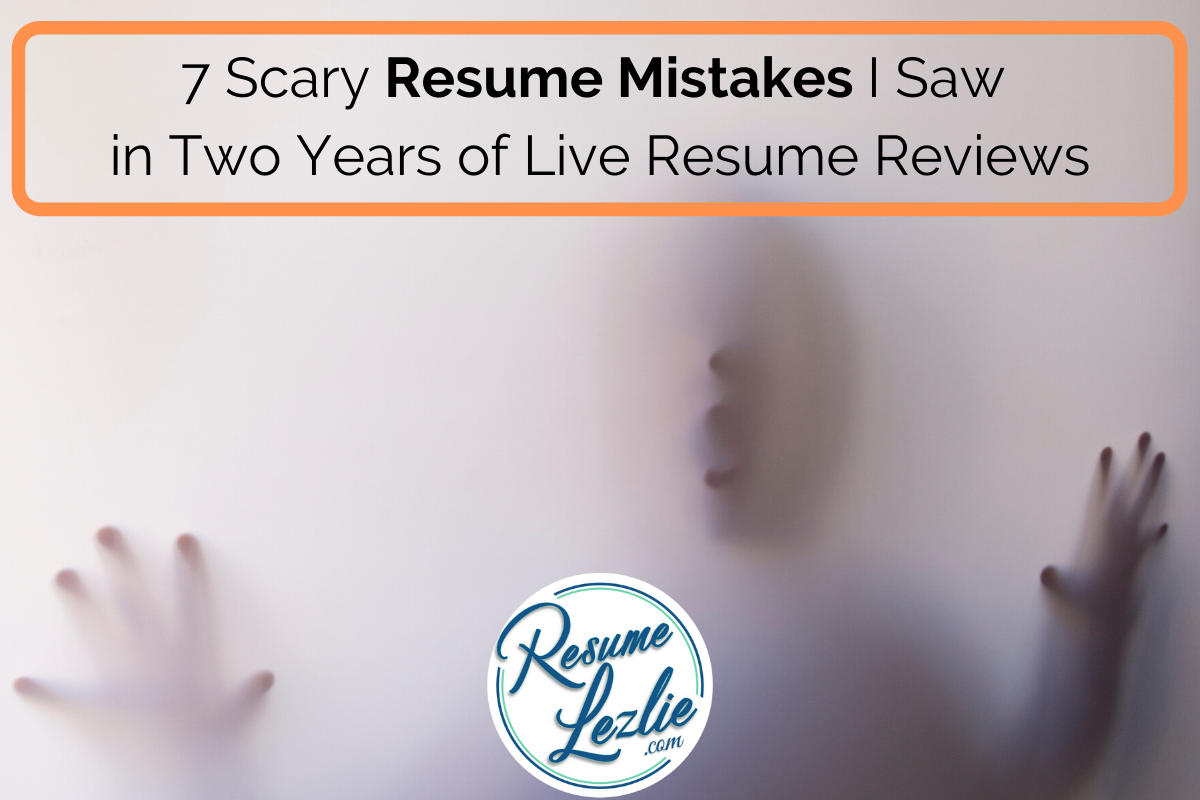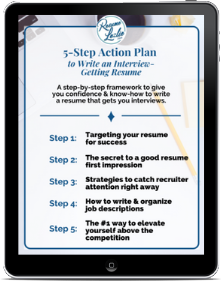Wanna make sure your resume is free of these 7 blunders? Download my interactive, easy-to-use 5-Step Action Plan to Write an Interview-Getting Resume.
When I first started my resume writing business, I got a gig offering live resume reviews at a monthly career fair.
I would sit at a table (completely alone, in the early days) and people would line up to have me review their resume and provide corrections, advice, tips, and any insider knowledge I could. It was a win-win situation because they got free expert feedback and I got exposure to literally hundreds (maybe even thousands) of resumes across numerous industries and career levels.
My booth immediately became the most popular (with lines out the door!) and I quickly discovered that many (many) people make a lot of the same resume mistakes – consistently across all the resumes I saw throughout my 2-year gig.
That’s because a LOT of the resume advice floating around online is outdated, completely inconsistent with what real-life recruiters want, and all-round just-plain bad.
So I compiled a list of some of these common mistakes and reached out to real recruiters, hiring managers, and other resume writers to (1) verify that these really were mistakes and not desirable aspects of effective resumes, and (2) ask if these mistakes were as common as I had found them to be.
Based on the feedback I’ve received, I complied the list below. I hope it helps! If you have any questions, I’m always happy to help so feel free to reach out to me at Lezlie@ResumeLezlie.com.
Don’t forget to download my interactive, easy-to-use
5-Step Action Plan to Write an Interview-Getting Resume.
Common Resume Mistakes to Avoid
Using an Objective
Instead of starting with an Objective, which tells the employer what you want, start with a Summary or Profile section which tells them what you can do for them. Detail the ‘big picture’ idea of what you’re best at and what you have to offer a potential employer. This works to engage the reader, establish your credibility, and set the tone for the rest of your resume.
This section should also include as many industry-relevant skills/keywords as possible, in order to help you in online applications, where most companies are using Applicant Tracking Systems (ATS) to screen resumes, and those ATS are programmed to find resumes that achieve a certain percentage keyword match between the resume and the job description. Including relevant skills also helps to pique the interest of real human beings reviewing your resume.
Foregoing the Summary and Skills Entirely
While it’s not advisable to start your resume with an Objective, it’s also not advisable to start directly out with your Education or Work Experience. Starting with those sections doesn’t do much to provide the reader with any sort of insight into who you are.
And while it’s true that employers are much more interested in what you can do for them, they’re also much more likely to invest time in your resume if there’s some sort of “hook” to get them started.
Using a strong headline or title line, a concise paragraph demonstrating your overall value, and a compelling list of highly relevant skills/keywords helps to get the reader more interested in learning more about you.
Only Including Skills at the Bottom of the Resume (Instead of the Top)
So, we’ve established that industry-relevant skills/keywords are important for (a) online applications and (b) having actual recruiters/hiring managers reviewing your resume.
While the positioning of those keywords doesn’t make a whole lot of difference to the ATS, it DOES make a big difference to a real human being. Skills added to the bottom of your resume are MUCH more likely to be overlooked than skills included in the top 1/3 of the first page.
Some industries, like technology, may have a larger number of relevant skills than would fit within the top 1/3 of the page. In those cases, I advise choosing the most relevant for the top section, and then including additional technical skills in a section towards the bottom. This will ensure those skills are still picked up by the Applicant Tracking System, but won’t distract from the top priorities in the top section of the resume.
Leaving Out Achievements
Including accomplishments, achievements, recognitions, etc. from you career experience is a great way to help elevate yourself above other candidates with similar experience. It shows recruiters/hiring managers that you not only know how to do the job, but you pride yourself in doing it well and going above-and-beyond to get it done right.
Just as important as including your achievements in HOW you include them. I see many resumes where the achievements are separated out into a section by themselves. I think the though process behind this is to make those achievements stand out more, but what it actually creates a loss of context so readers don’t have a full picture of your career timeline and when those achievements occurred.
Instead, it’s best to include your achievements under whichever job you held at the time the achievement occurred. You can still make them stand out by changing the formatting to make them more noticeable.
Dates on the Wrong Side
Most ATS are programmed to search for employment dates on the right-hand side of the page. Listing them elsewhere could result in those dates being overlooked, and possibly your resume being thrown out altogether.
Also, most hiring managers and recruiters prefer to find your dates listed along the right-hand column because it makes them easy to spot without having to work too hard. In the case of recruiters, be careful not to clutter up that side of the page too much. Don’t intentionally align any other content along that side of the page and use margin indents to keep your content from venturing all the way to the edge.
Using First-Person Language
Even though your resume is supposed to be about you, using first person language like ‘I’, ‘me’, and ‘my’ is not advisable. But you also don’t want to revert to referring to yourself in the third-person by repeatedly using your own name or even ‘he’ or ‘she’. Instead, it’s common practice in resumes to omit those words entirely, so instead of saying, “I am an engineer with over 10 years’ experience”, you would say, “Engineer with over 10 years’ experience”.
Including Personal Information (Photo, Age/DOB, Marital Status, Kids, etc.)
This kind of personal information doesn’t belong on a resume. These days, employers are very wary about engaging in practices which may open them up to liabilities and/or accusations of discrimination.
Because of this, most employers will often throw out resumes including photos, mentions of age, marital status, etc. By choosing not to deal with these resumes at all, they eliminate the chance of appearing to discriminate on the basis of age, gender, race, sexual orientation, etc.
Want more career-related goodness?
- Get a powerful 5-Step Resume Action Plan that will help you transform your resume into an interview-getting machine.
- Download my 54 Super Impressive Resume Action Verbs list by joining the Career Courage Facebook group.
- Find more DIY career resources here.
- Apply now for a free strategy call if you’re thinking about 1:1 services with a career expert.

